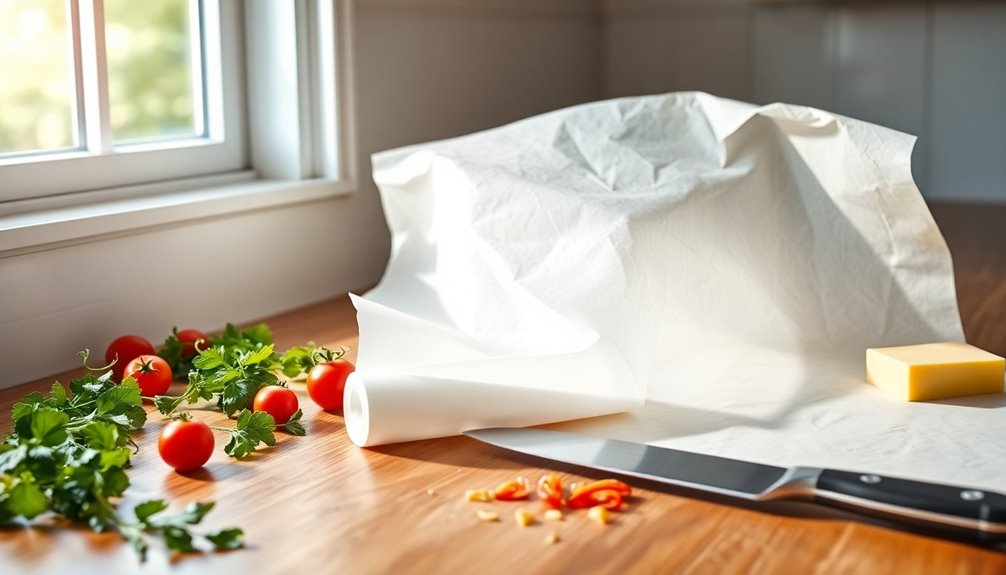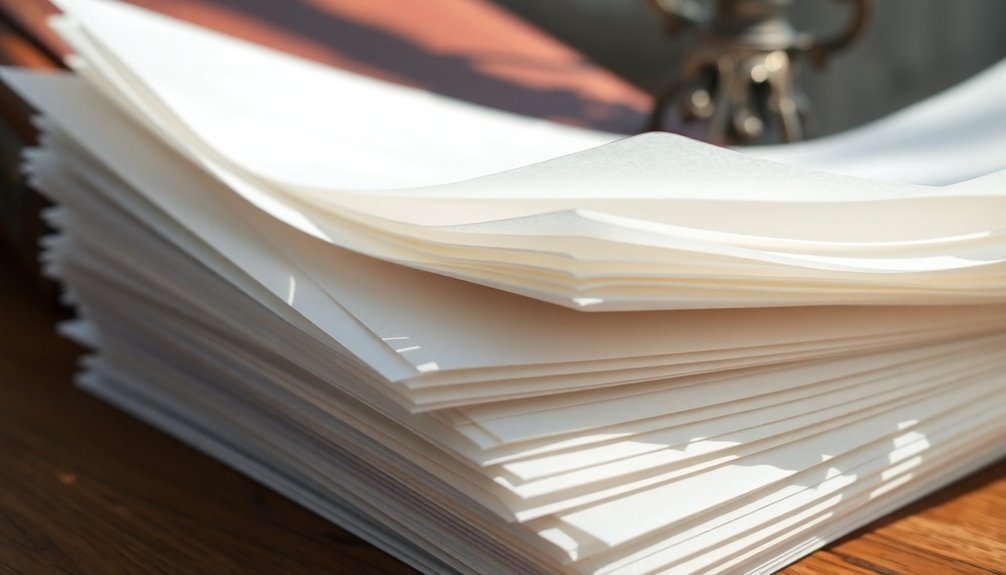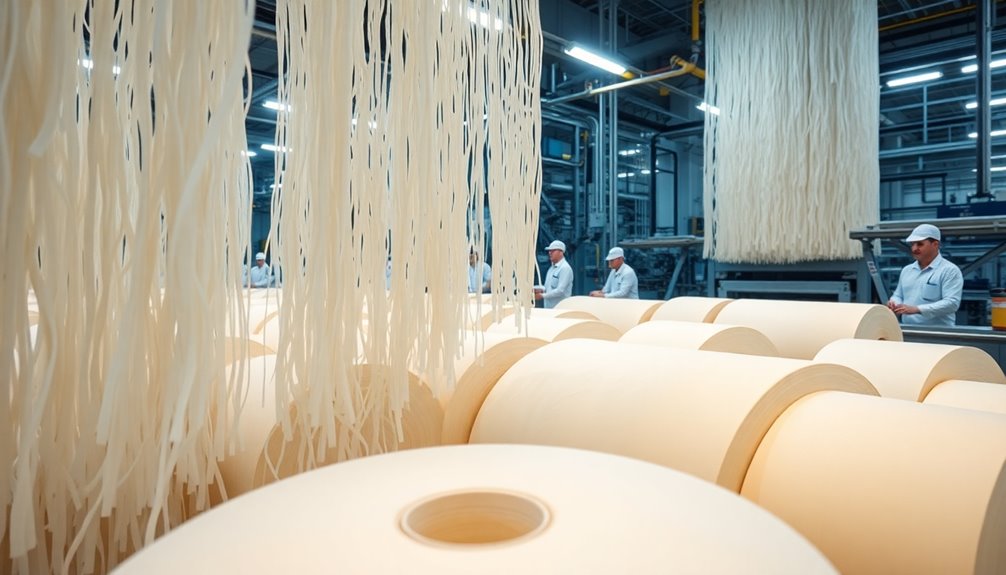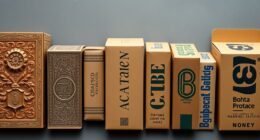Greaseproof paper has revolutionized how you store food and manage leftovers in the kitchen. While it's perfect for wrapping sandwiches and keeping moisture at bay, many people confuse it with baking paper. Greaseproof paper isn't designed for high-heat baking, leading to potential mishaps if used incorrectly. It excels in cold applications, offering a budget-friendly option for your food storage needs. However, understanding its limitations is vital for avoiding frustration while cooking. If you're curious about the best ways to use this simple product beyond storage, you'll find some surprising tips and tricks just ahead.
Key Takeaways
- Greaseproof paper revolutionized food storage by providing a moisture-resistant option for wrapping sandwiches and leftovers, enhancing freshness.
- Its ability to resist grease and oil makes it an ideal choice for food storage in the fridge and freezer.
- While budget-friendly, greaseproof paper's non-stick properties limit its effectiveness in baking, often causing sticking issues.
- Creative uses, such as lining containers and absorbing excess oil, demonstrate greaseproof paper's versatility beyond traditional baking.
- Understanding its limitations is crucial, as misuse in high-heat applications can lead to disappointing culinary results.
Kitchen Staple Misconceptions Revealed
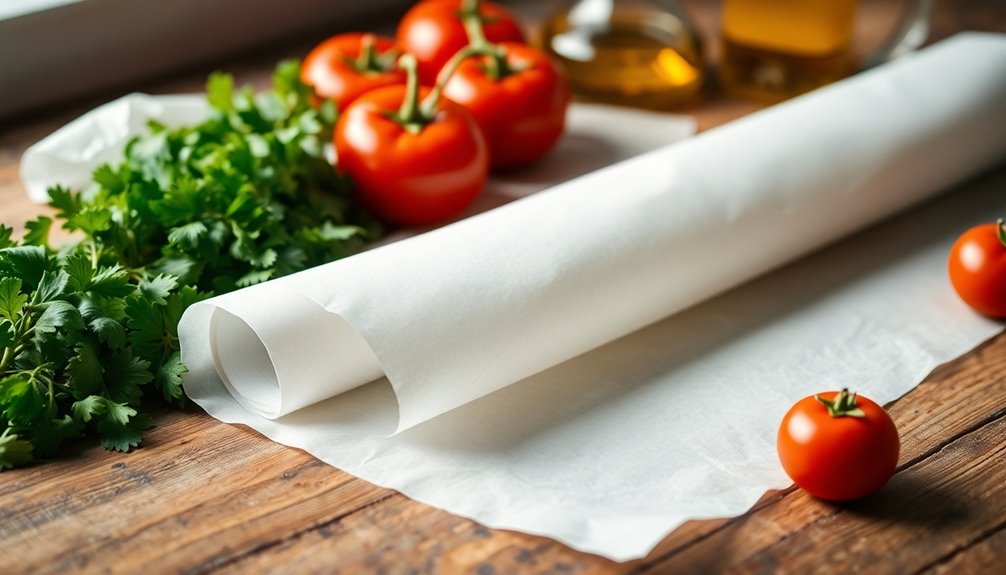
In recent years, many home cooks have been misled about the uses of greaseproof paper. This confusion often stems from the misconception that greaseproof paper can replace baking paper. While greaseproof paper is great for wrapping sandwiches and storing food in the fridge or freezer, it doesn't hold up in high-heat baking scenarios. You might find yourself frustrated when your cookies stick to the pan because greaseproof paper lacks the non-stick properties that silicone-coated baking paper offers.
The allure of budget-friendly options makes greaseproof paper tempting, especially at just $1.60 for 30 meters. However, this lower price can lead to baking failures when you mistakenly use it for lining trays or cake pans. As interest in kitchen hacks grows, so does the misuse of greaseproof paper in baking.
To prevent these mishaps, consumer education is crucial. Understanding the distinct properties of both greaseproof paper and baking paper can save you time, money, and culinary disappointment. So next time you're in the kitchen, remember to choose the right paper for the job to ensure your baking success.
Greaseproof vs. Baking Paper Differences
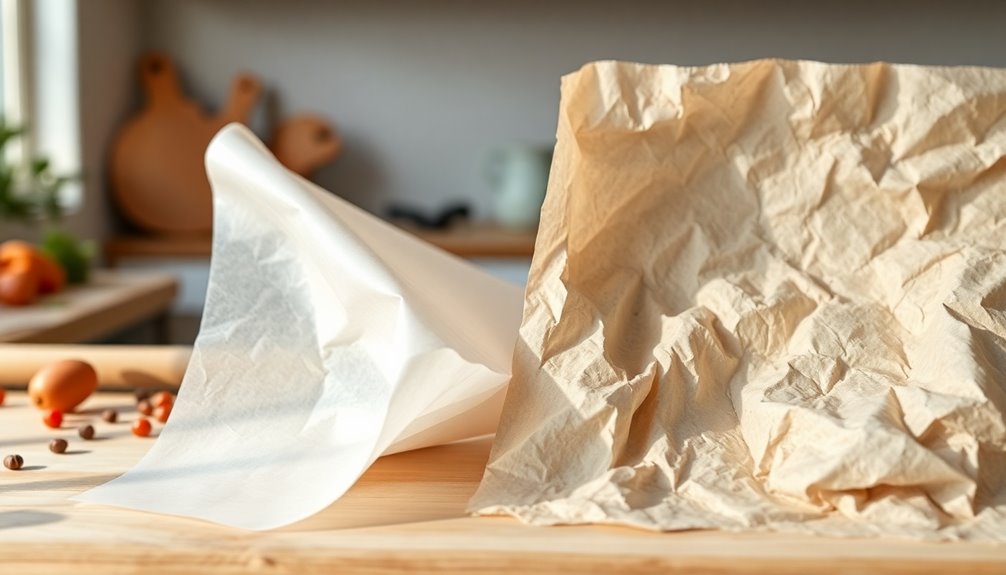
Understanding the differences between greaseproof and baking paper can save you from baking frustrations. Greaseproof paper is designed to resist grease and oil, making it perfect for food storage, such as wrapping sandwiches. However, it's not made for the oven and can lead to sticking issues with your baked goods. On the other hand, baking paper is coated with silicone, giving it a non-stick surface that allows your treats to release easily.
Using greaseproof paper in the oven can result in disappointment. Since it can't withstand high temperatures like baking paper, you might find your delicious cookies or cakes sticking to the paper. Many people mistakenly think these two papers are interchangeable because they look similar, leading to unsatisfactory baking results when the wrong type is used.
To ensure your baked goods turn out perfectly, always opt for baking paper when lining trays or pans. It's specifically designed for this purpose and can handle temperatures up to 230°C. By understanding these key differences, you can avoid common pitfalls and enjoy hassle-free baking every time.
Creative Uses for Leftover Paper

Leftover greaseproof paper can be surprisingly versatile in the kitchen. You can line containers with it when storing greasy leftovers, preventing mess and making cleanup a breeze. This simple product also shines when wrapping sandwiches; it keeps them fresh while blocking moisture from seeping in.
If you need to transfer dry ingredients or liquids, cut the paper into a funnel shape. It'll help you avoid spills, making your cooking process smoother. For those who love baking, you can create a non-stick surface by cutting the leftover paper into smaller pieces. This is fantastic for rolling out dough or shaping pastries, ensuring they release easily without sticking.
Additionally, leftover greaseproof paper can absorb excess oil from fried foods. Simply place your food on the paper to reduce greasiness and enhance presentation. These creative uses not only save you time but also help you make the most of every piece of greaseproof paper in your kitchen. So don't toss that leftover paper—get creative and turn it into a useful kitchen tool!
Benefits and Drawbacks Discussed
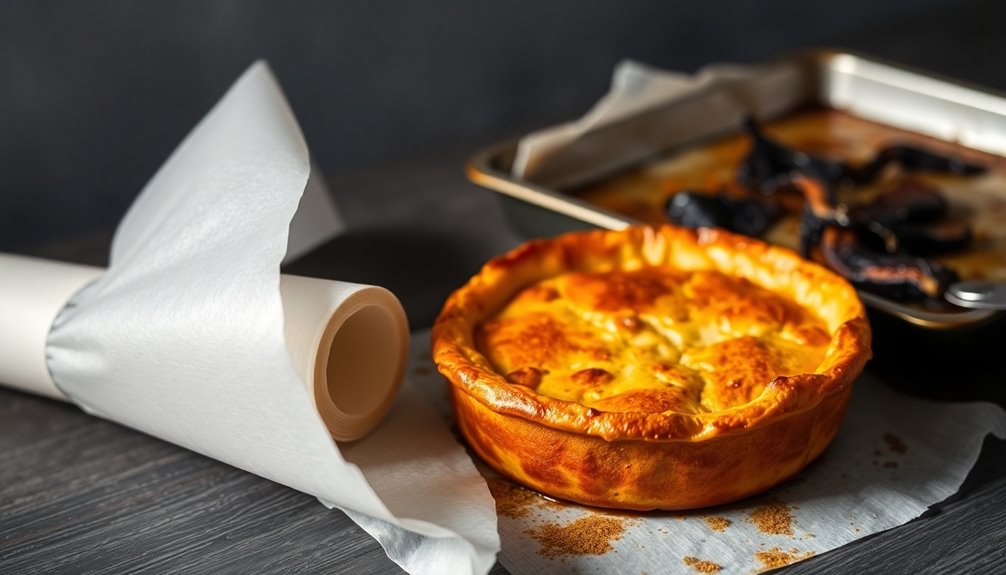
When considering greaseproof paper for your kitchen, it's important to weigh both its benefits and drawbacks. On the plus side, greaseproof paper is a budget-friendly option, costing about $1.60 for 30 meters. It's perfect for cold applications, like wrapping sandwiches or storing food in the fridge and freezer. This versatility makes it a staple in many kitchens, especially for those looking to save money.
However, the drawbacks are significant. Unlike baking paper, which can withstand temperatures up to 230°C due to its silicone coating, greaseproof paper isn't suitable for oven use. If you try using it for baking, you might face sticking issues, resulting in unsatisfactory outcomes. This can lead to frustration, especially if you're relying on it for specific cooking techniques that require non-stick properties.
The rising popularity of greaseproof paper in kitchen hacks has led to increased usage, but it's crucial to understand its limitations. Misusing greaseproof paper for baking tasks can lead to cooking mishaps, so always keep in mind the distinct differences between greaseproof paper and baking paper when planning your meals.
Baking Paper in Professional Kitchens

Baking paper is often favored in professional kitchens for its exceptional non-stick properties, allowing chefs to create beautifully presented dishes without the hassle of added fats or oils. You'll find that many culinary experts rely on baking papers for various cooking methods, including baking, roasting, and steaming. With a heat resistance of up to 230°C, these papers can handle high temperatures while ensuring your creations come out perfectly.
One of the standout features of baking paper is its ability to allow moisture to escape, which is crucial for achieving the perfect texture in baked goods. This prevents sogginess and promotes even cooking, ensuring that every dish is a success. Plus, the convenience of reusable baking paper means you can use it multiple times, enhancing cost-effectiveness in high-volume kitchens.
Additionally, using baking paper streamlines the clean-up process, as it minimizes food adherence to baking trays and pans. This standard practice in professional kitchens not only saves time but also maintains the quality of your culinary masterpieces. With baking paper, you can focus on creativity without worrying about the mess.
Key Distinctions Clarified
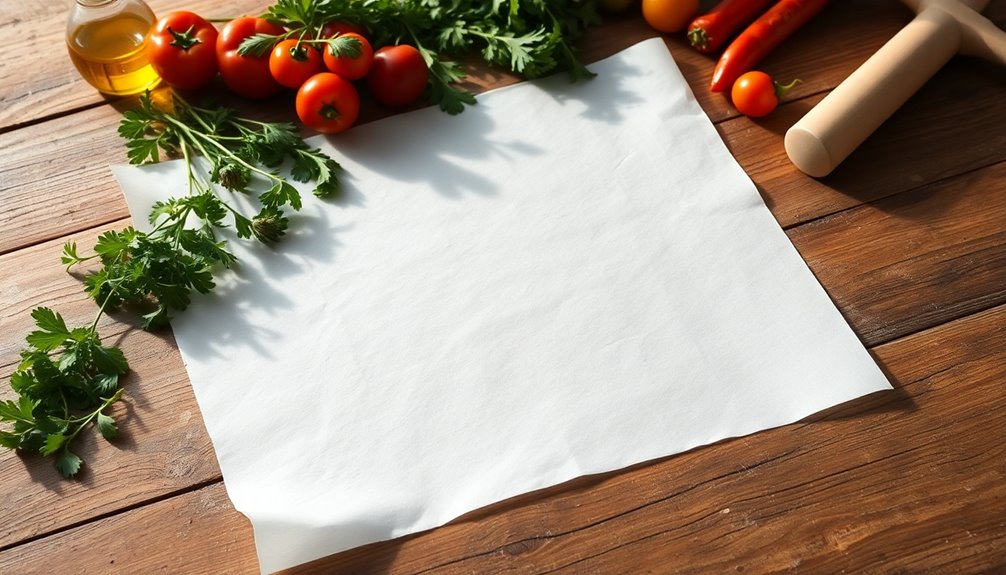
Understanding the differences between greaseproof paper and baking paper is essential for anyone who enjoys cooking or baking. Greaseproof paper is designed to resist grease and oil, making it perfect for storing and wrapping food items like sandwiches. However, it's not suitable for high-heat baking, as it lacks the non-stick properties needed for successful baking applications.
On the other hand, baking paper, also known as parchment paper, is coated with silicone, allowing it to endure temperatures up to 230°C. This feature makes it ideal for various uses in the kitchen, such as lining baking trays and cake pans. When you use baking paper, you'll find that food releases easily, preventing sticking and ensuring a successful baking experience.
Using greaseproof paper in baking can lead to disasters, as it doesn't have the same non-stick surface as baking paper. The confusion between these two types often stems from their similar appearances, which is why understanding their distinct properties is crucial. By knowing when to use each type, you can enhance your cooking and baking outcomes significantly.
Frequently Asked Questions
What Is Greaseproof Paper Used for in Cooking?
Greaseproof paper's perfect for wrapping and storing greasy foods, like sandwiches and baked goods. You'll find it keeps oil and moisture from seeping through, making it ideal for cold applications, especially in the fridge or freezer. It's budget-friendly and compostable too! Just remember, it's not suitable for high-heat baking, as it doesn't provide the necessary non-stick properties. So, use it wisely for food storage, but skip it for baking needs.
What Is the Function of Greaseproof Paper?
The function of greaseproof paper is to resist grease and oil, making it perfect for wrapping and storing food that contains fats. It helps keep sandwiches and pastries fresh while preventing them from sticking together. You'll find it's budget-friendly and compostable, aligning with eco-friendly practices. Just remember, it's not suitable for high-temperature cooking, as it can stick to food. Use it for cold applications to maintain quality and presentation.
Can You Bake Without Greaseproof Paper?
Yes, you can bake without greaseproof paper. Instead, use parchment paper or a silicone baking mat for better results. Parchment paper provides a non-stick surface and can handle high temperatures, ensuring your baked goods come out easily. If you don't have those options, you can grease your baking pan with butter or oil. Just remember, using greaseproof paper might lead to sticking and could ruin your baking efforts, so it's best to avoid it.
What Is Greaseproof Paper Called in the US?
In the US, greaseproof paper is typically called "grease-resistant paper." You'll find it commonly used for wrapping food items like sandwiches and pastries, preventing grease from seeping through. Just remember, it's not the same as baking paper; greaseproof paper isn't designed for high-heat applications, so using it to line baking trays can lead to sticking issues. It's a handy option for food storage and is often more affordable than baking paper.

